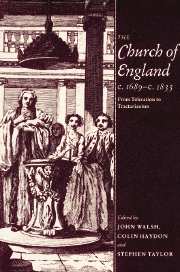Book contents
- Frontmatter
- Contents
- Preface
- List of Abbreviations
- 1 Introduction: The Church and Anglicanism in the ‘long’ eighteenth century
- Part I The pastoral work of the Church
- Part II Crisis and reform
- 5 The Church, the societies and the moral revolution of 1688
- 6 John Locke, Jonas Proast and religious toleration 1688–1692
- 7 The origins and ideals of the SPCK 1699–1716
- 8 Cultural patronage and the Anglican crisis: Bristol c. 1689–1775
- 9 Latitudinarianism at the parting of the ways: a suggestion
- 10 Ecclesiastical policy under Lord North
- 11 The foundation of the Church Missionary Society: the Anglican missionary impulse
- 12 A Hanoverian legacy? Diocesan reform in the Church of England c. 1800–1833
- Part III Identities and perceptions
- Index
9 - Latitudinarianism at the parting of the ways: a suggestion
Published online by Cambridge University Press: 13 October 2009
- Frontmatter
- Contents
- Preface
- List of Abbreviations
- 1 Introduction: The Church and Anglicanism in the ‘long’ eighteenth century
- Part I The pastoral work of the Church
- Part II Crisis and reform
- 5 The Church, the societies and the moral revolution of 1688
- 6 John Locke, Jonas Proast and religious toleration 1688–1692
- 7 The origins and ideals of the SPCK 1699–1716
- 8 Cultural patronage and the Anglican crisis: Bristol c. 1689–1775
- 9 Latitudinarianism at the parting of the ways: a suggestion
- 10 Ecclesiastical policy under Lord North
- 11 The foundation of the Church Missionary Society: the Anglican missionary impulse
- 12 A Hanoverian legacy? Diocesan reform in the Church of England c. 1800–1833
- Part III Identities and perceptions
- Index
Summary
The discussion that follows arises from an attempt to understand the problems faced by church reformers in the mid-eighteenth century. It relates the most controversial reformist work of the time, Archdeacon Blackburne's Confessional, to the Latitudinarian tradition and at the same time places it in the context of Enlightenment thinking. It begins by suggesting that although Latitudinarians and liberal Dissenters were facing similar problems, those facing the former were more acute. In order to demonstrate this, I have the temerity to attempt a brief characterization of the Latitudinarian tradition, before trying to demonstrate that the tensions in the tradition which had broadly been creative in the seventeenth century were ceasing to be so by the mid-eighteenth century. Blackburne's work attacked key elements in the Latitudinarian synthesis, and, in consequence, Latitudinarian reformers were forced to regroup leaving them in a weak position to resist the tide of conservative orthodox reaction which swept the country in the 1790s.
It is not difficult to see many links and parallels between Latitudinarians and Old Dissenters in the eighteenth century. They shared in many ways a common theological, philosophical and political outlook. They emphasized the relationship between religion and morality, between piety and civic virtue. They were tolerant of differences, stressed the common core of Christianity and placed the creeds and dogma at the margins of their concerns. They were not prepared to allow philosophical differences to outweigh their commitment to moderation and, in their different contexts, to the via media. Many still hoped for a comprehensive establishment.
- Type
- Chapter
- Information
- The Church of England c.1689–c.1833From Toleration to Tractarianism, pp. 209 - 227Publisher: Cambridge University PressPrint publication year: 1993
- 8
- Cited by

